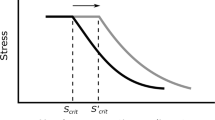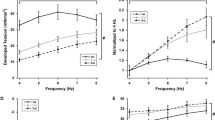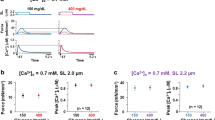Abstract
We studied the amount and time-course of tension recovery after quick releases (0.25 mm) during experimental tetanus, potassium chloride contracture (KCl), hypoxic contracture (H) as well as joint glucose and oxygen deficiency contracture (HG) in left ventricular papillary muscles of rat and right ventricular papillary muscles of cat myocardium. Both in experimental tetanus and KCl contracture, the tension recovery was finished within 200 ms after the release, and was 77% and 60% of initial tension fall, respectively.. The Q10 value for the time constant of half of recovery tension was 2.5, and the time constants differed by the same factor between rat and cat myocardium. In H or HG contracture, we never could find any significant tension recovery process during the first 200 ms after a release, neither in late nor in very early stages of contracture tension generation. However, when longer observation periods (90s) after a release were monitored, a slow tension recovery was observed which was at least 18% of initial tension fall.
This data indicates fast, calcium-mediated cross-bridge cycling in experimental tetanus and KCl contracture. In contrast, the very slow tension recovery in H and HG contracture, which is consistent with recent myothermal data, can be interpreted as rigorlike cross-bridges with a very slow cycling rate, a long time of attachment in force-generating position and low energy turnover.
Similar content being viewed by others
References
Barry WH, Brooker JZ, Alderman EL, Harrison DC (1974) Changes in diastolic stiffness and tone of the left ventricle during angina pectoris. Circulation 49:255–263
Best BM, Donaldson SKB, Kerrick WGL (1977) Tension in mechanically disrupted mammalian cardiac cells: effects of magnesium adenosine triphosphate. J Physiol (Lond) 264:1–17
Bing OHL, Fishbein MC (1979) Mechanical and structural correlates of contracture induced by metabolic blockade in cardiac muscle from the rat. Circ Res 45:298–308
Bing OHL, Brooks WW, Messer JV (1973) Heart muscle viability following hypoxia: protective effect of acidosis. Science 180:1297–1298
Bodem R, Sonnenblick EH (1974) Deactivation of contraction by quick releases in the isolated muscle of the cat. Circ Res 34:214–225
Bremel RD, Weber A (1972) Cooperation within actin filament in vertebrate skeletal muscle. Nat New Biol 238:97–101
Brenner B (1979) An indirect proof of stretch-induced Ca++ release from the sarcoplasmic reticulum in glycerinated skeletal and heart muscle preparations. Basic Res Cardiol 74:177–202
Bricknell OL, Daries PS, Opie LH (1981) A relationship between adenosine triphosphate, glycolysis and ischemic contracture in the isolated rat heart. J Mol Cell Cardiol 13:941–945
Cooley CA, Reul GJ, Wukasch CC (1972) Ischemic contracture of the heart: “Stone heart”. Am J Cardiol 29:575–577
Dwyer EM (1970) Left ventricular pressure-volume alterations and regional disorders of contraction during myocardial ischemia induced by atrial pacing. Circulation 42:1111–1122
Edman KAP (1966) The relation between sarcomere length and active tension in isolated semitendinosus fibres of the frog. J Physiol 183:407–417
Ford LE, Huxley AF, Simmons RM (1977) Tension responses to sudden length change in stimulated frog muscle fibres near slack length. J Physiol 269:441–515
Gibbs C, Loiselle D (1978) The energy output of tetanized cardiac muscle: Species differences. Pflügers Arch 373:31–38
Godt RE (1974) Calcium-activated tension of skinned muscle fibers of the frog: dependence on magnesium adenosine triphosphate concentration. J Gen Physiol 63:722–739
Gordon AM, Huxley AF, Julian FJ (1966) The variation in isometric tension with sarcomere length in vertebrate muscle fibres. J Physiol 184:170–192
Greene HL, Weisfeldt ML (1977) Determinants of hypoxic and posthypoxic myocardial contracture. Am J Physiol 232 (5):H526-H533
Grossman W, Barry WH (1980) Diastolic pressure-volume relations in the diseased heart. Fed Proc 39:148–155
Gudbjarnason S, Mathes P, Ravens KG (1970) Functional compartmentation of ATP and creatine phosphate in heart muscle. J Mol Cell Cardiol 1:325–339
Harris P (1975) A theory concerning the course of events in angina and myocardial infarction. Eur J Cardiol 3:157–163
Hauck G, Jacob R (1962) Der calciumbedingte Herzstillstand. Z Kreislaufforschg 51:1184–1196
Hearse DJ, Garlick PB, Humphrey SM (1977) Ischemic contracture of the myocardium: mechanisms and prevention. Am J Cardiol 39:986–993
Heinl P, Kuhn HJ, Rüegg JC (1974) Tension responses to quick length changes of glycerinated skeletal muscle fibres from the frog and tortoise. J Physiol 237:243–258
Henderson AH, Brutsaert DL, Parmley WW, Sonnenblick HE (1969) Myocardial mechanics in papillary muscles of the rat and cat. Am J Physiol 217:1273–1279
Henry PD, Sobel BE, Braunwald E (1974) Protection of hypoxic guinea pig hearts with glucose and insulin. Am J Physiol 226:(2):309–313
Henry PD, Shuchleib R, Davis J, Weiss ES, Sobel BE (1977) Myocardial contracture and accumulation of mitochondrial calcium in ischemic rabbit heart. Am J Physiol 233(6):H677-H684
Herzig JW (1978) A cross-bridge model for inotropism as revealed by stiffness measurements in cardiac muscle. Basic Res Cardiol 73:273–286
Hill DK (1964) The location of adenine nucleotide in the striated muscle of the toad. J Cell Biol 20:435–458
Holubarsch Ch, Alpert NR, Goulette R, Mulieri LA (1980) Energetics of hypoxic contracture in rat cardiac muscle. Eur J Physiol 384:R2
Holubarsch Ch (1980) Contracture type and fibrosis type of decreased myocardial distensibility. Different changes in elasticity of myocardium in hypoxia and hypertrophy. Basic Res Cardiol 75:244–252
Holubarsch Ch, Jacob R (1981) Diastolic tension of rat cardiac muscle during deficiency of oxygen and glucose. Stress-strain relationships and reversibility. Basic Res Cardiol 76:690–703
Holubarsch Ch, Alpert NR, Goulette R, Mulieri LA (1982) Heat production during hypoxic contracture of rat myocardium. Circ Res (in press)
Huxley AF, Simmons RM (1971) Proposed mechanism of force generation in striated muscle. Nature 233:533–538
Jacob R, Kissling G, Moser H, Schnizer W (1975) Zur Existenz einer hypoxischen oder regulativen Tonusminderung des Herzens. Verh Dtsch Ges Kreislaufforsch 41:267–271
Jacob R, Holubarsch Ch, Moser H, Brenner B (1980) Quantification of changes in myocardial elasticity under hypoxia. Advanc Clinical Cardiol 1:211–228
Jarmakani JM, Nagatomo T, Langer GA (1978) The effect of calcium and high-energy phosphate compounds on myocardial contracture in the newborn and adult rabbit. J Mol Cell Cardiol 10:1017–1029
Jewell BR (1977) A reexamination of the influence of muscle length on myocardial performance. Circ Res 40:221–230
Julian FJ, Sollins MR (1975) Variation of muscle stiffness with force at increasing speeds of shortening. J Gen Physiol 66:287–302
Katz AM, Tada M (1972) The “stone heart”: A challenge to the biochemist. Am J Cardiol 29:578–580
Kawai M (1978) Effect of MgATP on cross-bridge kinetics in chemically skinned rabbit psoas fibers as measured by sinusoidal analysis technique. In: Sugi H, Pollack GH (eds) Cross-bridge mechanism in muscle contraction. University of Tokyo Press
Lewis MJ, Housmans PR, Claes VA, Brutsaert DL, Henderson AH (1980) Myocardial stiffness during hypoxic and reoxygenation contracture. Cardiovasc Res 14:339–344
Mauriello GE, Sandow A (1958) Active state of muscle in iodoacetate rigor. J Gen Physiol 42:865–881
Morad M (1969) Contracture and catecholamines in mammalian myocardium. Science 166:505–506
Nayler WG, Grau A, Slade A (1976) A protective effect of verapamil on hypoxic heart muscle. Cardiovasc Res 10:650–662
Nayler WG, Poole-Wilson PA, Williams A (1979) Hypoxia and Calcium. J Mol Cell Cardiol 11:683–706
Rich TL, Brady AJ (1974) Potassium contracture and utilization of high-energy phosphates in rabbit heart. Am J Physiol 226:105–113
Rüdel R, Taylor SR (1971) Striated muscle fibres: faciliation of contraction at short muscle length by caffeine. Science 172:387–388
Scheuer J, Stezoski SW (1970) Protective role of increased myocardial glycogen stores in cardiac anoxia in the rat. Circ Res 27:835–849
Steiger GJ, Brady AJ, Tan ST (1978) Intrinsic regulatory properties of contractility in the myocardium. Circ Res 42:339–350
Ventura-Clapier R, Vassort G (1981) Rigor tension during metabolic and ionic rises in resting tension in rat heart. J Mol Cell Cardiol 13:551–561
Weber A (1969) Parallel response of myofibrillar contraction and relaxation to four different nucleoside triphosphates. J Gen Physiol 53:781–791
Weber A, Murray JM (1973) Molecular control mechanisms in muscle contraction. Physiol Rev 53:612–673
Wojtczak J (1979) Contractures and increase in internal longitudinal resistance of cow ventricular muscle induced by hypoxia. Circ Res 44:88–95
Yamamoto T, Herzig JW (1978) Series elastic properties of skinned muscle fibres in contraction and rigor. Pflügers Arch 373:21–24
Author information
Authors and Affiliations
Additional information
This work was supported by the Deutsche Forschungsgemeinschaft
Rights and permissions
About this article
Cite this article
Holubarsch, C. Force generation in experimental tetanus, KCl contracture, and oxygen and glucose deficiency contracture in mammalian myocardium. Pflugers Arch. 396, 277–284 (1983). https://doi.org/10.1007/BF01063931
Received:
Accepted:
Issue Date:
DOI: https://doi.org/10.1007/BF01063931




